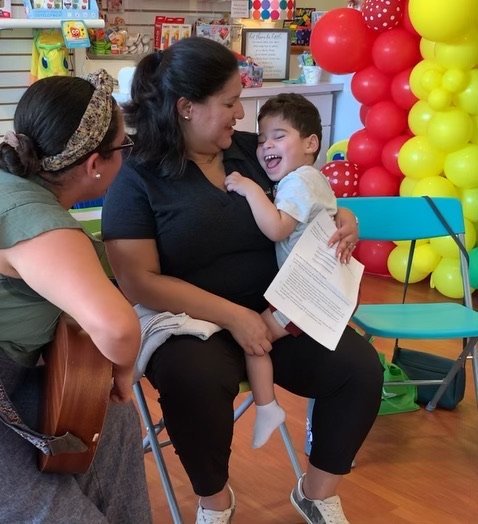Music in Early Childhood Development
The adage "music makes your baby smarter," is a sentiment that resonates with many of us. And in response, many of us, myself included, were placed in music lessons or groups either in school or as an extracurricular activity. These childhood music experiences often leave impressionable memories. Personally, my own journey with music—from childhood lessons to school programs—culminated in my decision to become a music therapist.
Music therapy is a research-based, clinical approach using music to achieve non-musical goals tailored to individual needs. In my work with children, the focus is on using music as a medium to cultivate essential skills. However, the benefits of incorporating music into a child's life extend beyond formal therapy sessions.
Music and Development
From the earliest days, caregivers instinctively use music as a tool to soothe, bond with, and engage their infants—a practice known as "infant-directed singing." This age-old tradition involves specific musical characteristics, creating a gentle, loving tone, a higher pitch, a slower speed, and a lulling or gliding quality. These characteristics not only capture infants' attention but also sustain their focus and often even bring about vocal responses from the babies.
As children progress through the stages of development, they simultaneously embark on a musical journey. Infants demonstrate an innate ability to discern different pitches, vocalize in a melodic manner, and respond physically to rhythmic sounds. Babies may also display specific musical preferences (calm, slow, and soft music). As babies grow into toddlers, you may notice them synchronize their movements to a steady beat, or imitate melodies to songs if they don’t know all the words. These skills eventually culminate as the joyful singing and dancing characteristic of preschoolers.
🎙 We had the honor of interviewing Alexa on the NICU Alumni podcast. You can listen to our conversation here. 🎙
Music and Play
Music provides a structured, engaging, and playful avenue for learning. When a child sings a song, musical elements like the way a song is organized (song form), melody, and rhythm, help them to practice non musical skills. Through music you can target things like learning new vocabulary words or following directions. For many children, music captures and holds their attention--not an easy task!--and encourages them to model and imitate the sounds and actions of others. Musical play not only offers opportunities for modeling and imitating, it also fosters success-oriented experiences, boosting a child's confidence. For instance, if a child struggles with following directions, “If You’re Happy and You Know It” can be a musical way to practice following directions while singing and dancing.
Music adds an extra layer to the typical play experience, introducing children to a variety of sounds through different instruments and musical styles. Music also pairs wonderfully with props, or images. This multisensory approach supports sensory stimulation, tolerance, and integration, enabling children to absorb information through various channels.
It is important to remember that just like adults have preferences for music or leisure activities, kids have their unique play and musical preferences. So, go on a little exploration with your child to find what engages them.
Tips for Using Music at Home
Sing it out! Start with infant-directed singing, but as they grow continue singing with them. Have dance parties, sing-alongs, and play-alongs with instruments. This provides time to bond, laugh, and play, all while modeling things like motor skills to play instruments or dance, and vocabulary development with song lyrics.
Incorporate music into playtime or as a motivator. Explore toys like play mats and mobiles that make sounds for babies. As your child grows, introduce different types of music and instruments. Some instrument suggestions that are playful and engaging (with links for the unfamiliar ones) are:
Maracas/ Egg Shakers
Tambourines
Drums
Scarves
You can even make homemade instruments with things around the house like water bottles, paper plates, or even pots and pans.
Embrace multi-sensory learning by using a combination of music, props, toys with light, toys with texture, and/or sensory bins. The more channels children engage with during play, the more opportunities they have to take in information and learn. Need ideas? Here are some resources I use to help inspire activities and for finding children’s songs:
Super Simple Songs: Great for finding simple, familiar versions of children's songs in both English and Spanish, also on IG @supersimpleofficial.
Music for Kiddos: Music therapist and educator who writes music for children, also on IG @Music_for_kiddos.
Resound Music Therapy: Music therapist who shares songs and activities on social media @resoundmusictherapy.
More Social Media Accounts that share great resources and DIY activities:
@Early.explorer: DIY Activities, Crafts, Play-Based Learning.
@busytoddler: Their mission is to bring hands-on play and learning back to childhood, support others in their parenting journey, and help everyone make it to nap time. :)
@dayswithgrey: Sharing playful activities for kids.
Brands that have great sensory toys and also share resources and DIY activities:
@Lovevery: Products designed by experts for the child's developing brain.
@Learningresources: Educational toys that help kids develop a lifelong love of learning while building essential school-ready skills.
@Lakeshorelearning: A leading developer and retailer of top-quality educational materials for early childhood programs, elementary schools and homes nationwide.
@Beginlearning: Resources and products that promote early learning.
Remember: It’s not about putting on a music performance for your child, but rather making music with your child as a form of play! Get silly, get loud, get creative, and have fun!

